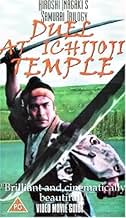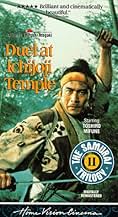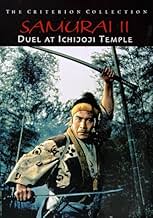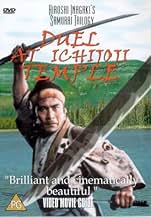IMDb RATING
7.3/10
7.3K
YOUR RATING
Musashi Miyamoto returns to Kyoto after years of absence. After a series of fights against the Yoshioka School, he challenges its master to a duel.Musashi Miyamoto returns to Kyoto after years of absence. After a series of fights against the Yoshioka School, he challenges its master to a duel.Musashi Miyamoto returns to Kyoto after years of absence. After a series of fights against the Yoshioka School, he challenges its master to a duel.
Featured reviews
Samurai II picks up where the first film left off; Takezo, now Miyamoto Musashi (Toshiro Mifune) has been released by the priest and is clearly more disciplined after having absorbed his teaching. After we see him dispatch a foe swinging a wicked kusarigama, however, an old man who's witnessed the affair comments that he lacks chivalry, and taking this next step in his development is the subject of this installment in the trilogy. Mifune is wonderful and joined by many of the characters from the first film, as well as the leader of an unscrupulous samurai school (Akihiko Hirata) and another samurai, Sasaki Kojiro, who is clearly on the path to higher development (Koji Tsuruta). Unfortunately, while there are some really fine moments, narratively the film is bit tangled, which kept me from truly loving it.
For one thing, I think it was a mistake to have Musashi meet Otsu (Kaoru Yachigusa) again so early in the story, then to have another dramatic scene where he tells her he's chosen the way of the sword instead of the way of love, since this had already had been done with great effectiveness at the end of the first film. Later he's also tempted by a courtesan in a scene reminiscent of the widow and her daughter trying to seduce him, and naturally, he rebuffs her too. The main story line is Musashi and it consists mostly of him turning down women throwing themselves at his feet or being hunted by his enemies, which I didn't find all that creative.
Meanwhile, there are lots of other subplots, none of which are satisfying. There is one involving the widow's daughter (Mariko Okada), who is in part a sympathetic character because she's prostituted by her own mother, but also in part a villain, lying to Otsu by telling her that Musashi is hers, and trying to steal him as she did with Otsu's fiancé Matahachi (Sachio Sakai) in the first film. The cowardly Matahachi has fallen into ignominy, and along with his venomous mother become threats out of "honor" to the family name. A brother to the leader of the samurai school gets in the act and also wants to challenge Musashi out of honor. While there is a lot of talk about honor from these kinds of characters, what we actually see is a lot of dishonorable behavior from everyone other than Musashi, Otsu, the priest, and Sasaki. I liked the contrast formed between good and evil, but just felt the number of characters involved could have been reduced to allow for more depth on the others. I have to say, I also disliked the ending, and not just because it was predictable. It's great that Musashi knows that "no means no," and it's a contrast to the rape another man commits earlier in the film, but his response was also pretty flawed.
All of that complaining aside, this is certainly a decent samurai film and it had its moments. Even though the film didn't seem to have a terribly large budget and the scenes shot at the studio are obvious, the cinematography is excellent. The swirling scenes leading up to battle and how colors are often contrasted with dark backgrounds are wonderful. The final battle sequence out in the rice paddy was very well filmed, and the taut precision of the samurai form was beautifully brought out by Mifune. From the perspective of craftsmanship it may be better than the first film, but from the perspective of narrative, it was a step down. Still, it's worth seeing.
For one thing, I think it was a mistake to have Musashi meet Otsu (Kaoru Yachigusa) again so early in the story, then to have another dramatic scene where he tells her he's chosen the way of the sword instead of the way of love, since this had already had been done with great effectiveness at the end of the first film. Later he's also tempted by a courtesan in a scene reminiscent of the widow and her daughter trying to seduce him, and naturally, he rebuffs her too. The main story line is Musashi and it consists mostly of him turning down women throwing themselves at his feet or being hunted by his enemies, which I didn't find all that creative.
Meanwhile, there are lots of other subplots, none of which are satisfying. There is one involving the widow's daughter (Mariko Okada), who is in part a sympathetic character because she's prostituted by her own mother, but also in part a villain, lying to Otsu by telling her that Musashi is hers, and trying to steal him as she did with Otsu's fiancé Matahachi (Sachio Sakai) in the first film. The cowardly Matahachi has fallen into ignominy, and along with his venomous mother become threats out of "honor" to the family name. A brother to the leader of the samurai school gets in the act and also wants to challenge Musashi out of honor. While there is a lot of talk about honor from these kinds of characters, what we actually see is a lot of dishonorable behavior from everyone other than Musashi, Otsu, the priest, and Sasaki. I liked the contrast formed between good and evil, but just felt the number of characters involved could have been reduced to allow for more depth on the others. I have to say, I also disliked the ending, and not just because it was predictable. It's great that Musashi knows that "no means no," and it's a contrast to the rape another man commits earlier in the film, but his response was also pretty flawed.
All of that complaining aside, this is certainly a decent samurai film and it had its moments. Even though the film didn't seem to have a terribly large budget and the scenes shot at the studio are obvious, the cinematography is excellent. The swirling scenes leading up to battle and how colors are often contrasted with dark backgrounds are wonderful. The final battle sequence out in the rice paddy was very well filmed, and the taut precision of the samurai form was beautifully brought out by Mifune. From the perspective of craftsmanship it may be better than the first film, but from the perspective of narrative, it was a step down. Still, it's worth seeing.
The follow-up to 1954's excellent Musashi Miyamoto, Duel at Ichijoji Temple picks up the story several years later, as an exiled orphan-turned-swordsman gains notoriety via a bloody tour of fatal duels. His reputation precedes him in returning to his hometown, where old rivals of both a violent and intimate nature await. This is a film about personal growth - specifically that of the samurai himself, who struggles to learn the key concepts of what his new life actually entails and where the rift lies between honor and reverence. We're never quite sure if Musashi takes this lesson to heart, particularly since he's so keen to maintain an impenetrable outer facade in almost every situation. It's a tricky role for period veteran Toshiro Mifune, who struggles with the more nuanced, flatter aspects of the character. In the previous episode, with the fires of young-adulthood to toy with, he excelled. Here, faced with the malaise of mid-life and the accompanying questions of his own being, his performance is far less sublime. The plot, cramped with too many faces and several seemingly-pointless subplots, does him no favors in dancing around the issues and repeating itself on more than one occasion. This could have been an excellent one-act show, and the final half-hour could still stand alone as precisely that. It lacks the gumption of its predecessor, however, and too often cuts away just as the action is getting good.
"Miyamoto Musashi" was already a great movie but this movie is even a better one on basically every front.
This movie is part of a real trilogy, that follows one story and one main character. It's therefore also best to watch these 3 movies in a row, to appreciate it best. All 3 movies closely follow each other, in which the first movie is being really used as a movie to set up things, while this second movie is mostly being used to build up to its climax that will occur in the third movie.
This time the movie flows better because the story gets used better as well. Like mentioned earlier, the first movie was still being mostly a setup movie for the series. In this movie we actually get to see more epic moments and fights, as it follows the further travels of Musashi Miyamoto, on his way to become a master-swordsman. Its story and different characters all work out nicely, as things also gets developed more, with its drama and romance.
There are a couple of really great fight sequences, of course mostly featuring Toshirô Mifune. It makes the movie often exciting to watch, as does the overall look for the movie. The movie benefits from its beautiful natural environments, as well as some nicely done studio work. Using color wasn't quite that common yet for '50's Japanese cinema, since it was quite costly and not as advanced yet as in the western world. However color had always worked out nicely for these three movies and it helps to make the movie a really great looking one. You also have to give credit for this to the movie its cinematography, done by Jun Yasumoto, who strangely enough worked on just the first two movies but didn't shot the third and final one.
A movie that really has everything in it.
9/10
http://bobafett1138.blogspot.com/
This movie is part of a real trilogy, that follows one story and one main character. It's therefore also best to watch these 3 movies in a row, to appreciate it best. All 3 movies closely follow each other, in which the first movie is being really used as a movie to set up things, while this second movie is mostly being used to build up to its climax that will occur in the third movie.
This time the movie flows better because the story gets used better as well. Like mentioned earlier, the first movie was still being mostly a setup movie for the series. In this movie we actually get to see more epic moments and fights, as it follows the further travels of Musashi Miyamoto, on his way to become a master-swordsman. Its story and different characters all work out nicely, as things also gets developed more, with its drama and romance.
There are a couple of really great fight sequences, of course mostly featuring Toshirô Mifune. It makes the movie often exciting to watch, as does the overall look for the movie. The movie benefits from its beautiful natural environments, as well as some nicely done studio work. Using color wasn't quite that common yet for '50's Japanese cinema, since it was quite costly and not as advanced yet as in the western world. However color had always worked out nicely for these three movies and it helps to make the movie a really great looking one. You also have to give credit for this to the movie its cinematography, done by Jun Yasumoto, who strangely enough worked on just the first two movies but didn't shot the third and final one.
A movie that really has everything in it.
9/10
http://bobafett1138.blogspot.com/
Samurai II: Duel at Ichijoji Temple is the second part of the so-called Samurai trilogy by Inagaki Hiroshi about legendary historical figure Miyamoto Musashi who was a highly accomplished samurai who wasn't only a great fighter but also an intellectual philosopher and a skilled artist. This movie shows how a young ronin travels the country for enlightenment and training for several years to become an accomplished samurai.
The main plot of the movie focuses on Miyamoto Musashi challenging a martial arts school. He also meets respectable opponent Sasaki Kojiro who he will eventually fight in the last film. His relationship with Otsu is further explored as she patiently waits for his destiny to be fulfilled.
In comparison to the first movie, this sequel has more fight scenes that are quite dynamic, epic and tense. The movie starts with an impressive duel and ends with a fight between Miyamoto Musashi on one side and eighty martial arts school students on the other side. The film has an overall quicker pace than the first part and is thoroughly entertaining.
All beloved characters from the first movie are back in the sequel and Mifune Toshiro's acting skills are once again quite impressive even though he seems to be acting too impulsively at times to portray a character who has undergone changes to find peace of mind. Mifune Toshiro fits the role much better in the energetic first film and accomplished third movie of the trilogy.
The main reason why this movie is the weakest part of the trilogy is because it skips three years in the life of Miyamoto Musashi and fails to tell how the protagonist has changed. This is even more inappropriate regarding the side characters. The last time we saw the protagonist's childhood friend Matahachi, he was engaged to Otsu but had parted with beautiful Akemi and her manipulative mother Oko to protect them against bandits. Three years later, he has suddenly married Oko who is though having a romantic relationship with Toji who works for a wealthy martial arts school owner whom he expects to marry Akemi and hopes to make lots of money in the process. It's never explained how Oko and Matahachi got married, how their relationship failed and how Toji met the unstable trio.
Despite a few plot holes and some lack of character development, it's essential to watch Samurai II: Duel at Ichijoji Temple as a link between the energetic first film and the accomplished third movie. This second part is still entertaining with its wonderful cinematography, improved fight scenes and plot filled with sinister intrigues. Don't jump on the tiring Game of Thrones bandwagon and watch this movie instead which offers similar contents with more style.
The main plot of the movie focuses on Miyamoto Musashi challenging a martial arts school. He also meets respectable opponent Sasaki Kojiro who he will eventually fight in the last film. His relationship with Otsu is further explored as she patiently waits for his destiny to be fulfilled.
In comparison to the first movie, this sequel has more fight scenes that are quite dynamic, epic and tense. The movie starts with an impressive duel and ends with a fight between Miyamoto Musashi on one side and eighty martial arts school students on the other side. The film has an overall quicker pace than the first part and is thoroughly entertaining.
All beloved characters from the first movie are back in the sequel and Mifune Toshiro's acting skills are once again quite impressive even though he seems to be acting too impulsively at times to portray a character who has undergone changes to find peace of mind. Mifune Toshiro fits the role much better in the energetic first film and accomplished third movie of the trilogy.
The main reason why this movie is the weakest part of the trilogy is because it skips three years in the life of Miyamoto Musashi and fails to tell how the protagonist has changed. This is even more inappropriate regarding the side characters. The last time we saw the protagonist's childhood friend Matahachi, he was engaged to Otsu but had parted with beautiful Akemi and her manipulative mother Oko to protect them against bandits. Three years later, he has suddenly married Oko who is though having a romantic relationship with Toji who works for a wealthy martial arts school owner whom he expects to marry Akemi and hopes to make lots of money in the process. It's never explained how Oko and Matahachi got married, how their relationship failed and how Toji met the unstable trio.
Despite a few plot holes and some lack of character development, it's essential to watch Samurai II: Duel at Ichijoji Temple as a link between the energetic first film and the accomplished third movie. This second part is still entertaining with its wonderful cinematography, improved fight scenes and plot filled with sinister intrigues. Don't jump on the tiring Game of Thrones bandwagon and watch this movie instead which offers similar contents with more style.
This comment about the "Samurai Trilogy" starts on the page for Miyamoto Musashi (Samurai I). My first viewing of the second episode was memorable because I got to take the train into town all by myself, and view it in a Tokyo theater. The first episode had just been shown on base, in a sort of cultural exchange, and my parents saw it and were pleasantly non-outraged-- I was a 9-year-old samurai-movie addict, and they believed enthusiasm beyond a certain intensity should be curbed. It was the same conflict as comic books some few years earlier. Technicolor was a big deal back then, especially in Japan, and it became the issue on which my viewing of "swordfighting movies" was decided-- the ones in color were historical films worth viewing, and even had something to teach. The black-and-white ones shown in Irumagawa and surrounding villages-- I had to sneak off to see. Ichijoji no Ketto (Duel at Ichijoji Temple) shows Miyamoto-san's achievements, while barring no holds on the issue of what they cost him. The romantic subplot continues, though its development in the western sense (toward union, wedded bliss) is thwarted at every turn. The issue is always a conflict between love and duty, and each deferment of gratification spells out a new step in the redefinition of the national character that is being mapped here. Again, some of the importance of all this is lost, even to modern Japanese audiences for whom the issues are long settled-- at the time, though, they were cliffhangers. A new character is introduced, Kojiro Sasaki who will emerge in part 3 as a rival for Musashi-- his equal except for certain features in their respective character. By the way, the score is excellent and haunting-- it extends like a symphony through all three parts, and has a leitmotif "hook" that will cause your ears to pick up in recognition, perhaps years from now, when you hear it again.
Did you know
- TriviaMusashi Miyamoto (Toshiro Mifune) is seen carrying two swords. This was a samurai custom known as daisho. Translated this means 'big-little'. The bigger of the two blades was the curved katana, which was generally used for combat and duelling. The short sword was the wakizashi, this blade was generally associated with committing seppuku, however, as can be seen in the film was also used for combat.
- GoofsMany of the guys killed in swordplay go down with either no visible contact between their bodies and a katana, or appear to be hit in the arm or leg with a non-fatal slash that stills ends them, regardless.
- Quotes
Musashi Miyamoto (Takezo): I renounce my love of women.
- ConnectionsFeatured in La Voie de la lumière (1956)
- How long is Samurai II: Duel at Ichijoji Temple?Powered by Alexa
Details
- Release date
- Country of origin
- Language
- Also known as
- Samurai II: Duel at Ichijoji Temple
- Filming locations
- Production company
- See more company credits at IMDbPro
- Runtime1 hour 44 minutes
- Sound mix
- Aspect ratio
- 1.37 : 1
Contribute to this page
Suggest an edit or add missing content

































